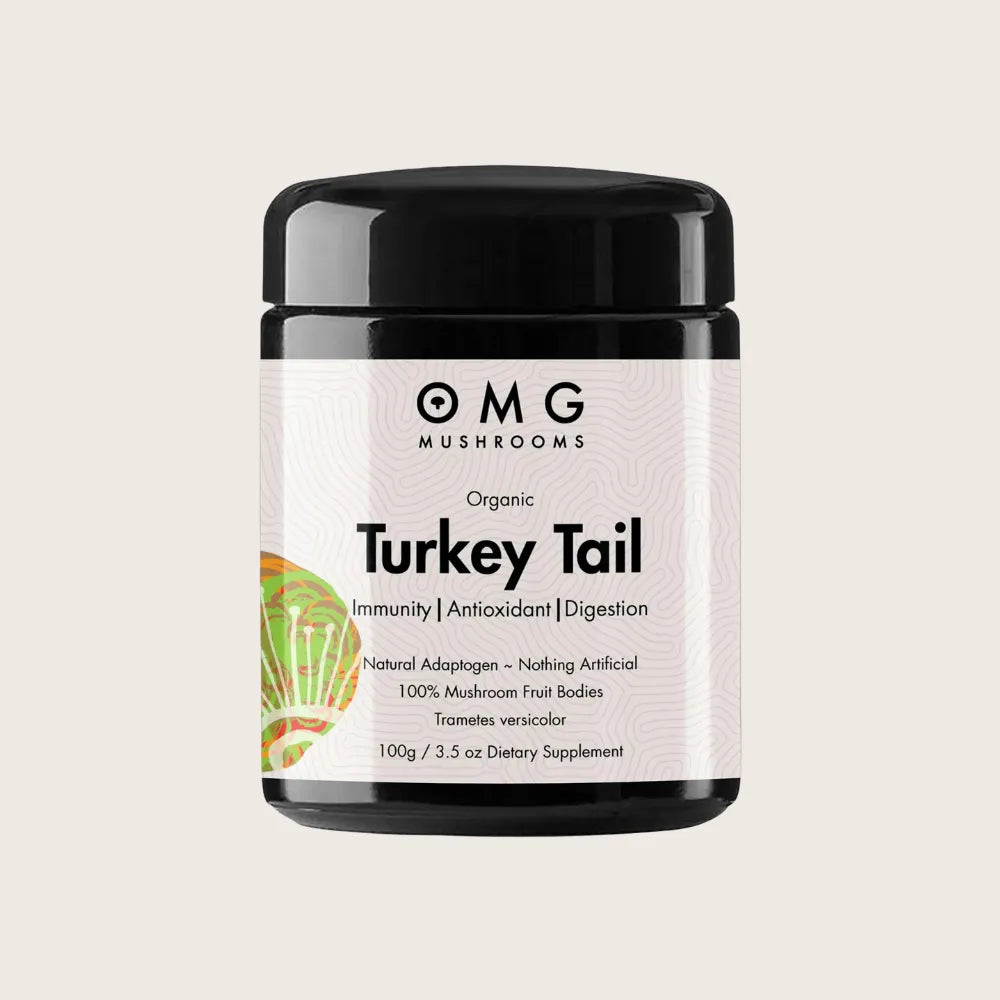Turkey Tail – The Rainbow Mushroom

THE ‘RAINBOW MUSHROOM’
Turkey Tail (also known as Coriolus versicolor) a deeply researched medicinal mushroom, has garnered significant attention in scientific circles and is actively integrated into cancer treatment protocols in Japan. Renowned for its immune-boosting properties, Turkey Tail houses a range of polysaccharides, making it a potent antiviral agent.
In Traditional Chinese Medicine, this mushroom is employed to stimulate the spleen-pancreas complex, aiding in the reduction of tissue formations associated with phlegm accumulation. It plays a crucial role in dispersing dampness, unblocking energy flow (Qi), and tonifying vital energy.
Key compounds found in Turkey Tail include beta-glucans, mannitol, and notable proteoglycans like polysaccharide K (PSK) and polysaccharide peptide (PSP), along with sterols. The extensive study of glycoproteins, particularly PSK, has paved the way for potential drug development.

THERAPEUTIC PROPERTIES, OF TURKEY TAIL
Turkey Tail, has been extensively studied for its therapeutic potential, particularly in the realm of immunology. Researchers have delved into its ability to enhance immune responses and activate natural killer (NK) cells. Clinical trials have explored its role in integrative support, with a focus on improving survival rates when used in conjunction with other treatments. Renowned as one of the most scrutinized mushrooms in modern science, Coriolus extracts, rich in compounds like PSK, have been integrated into primary cancer treatments in Japan since the 1980s.
A key highlight of Turkey Tail lies in its immune-boosting properties, notably enhancing the activity of macrophages, T lymphocytes, and NK cells. These properties prove beneficial across various infectious conditions, whether viral, bacterial, or fungal in origin. Additionally, its immunoregulatory effects play a crucial role in normalising overactive immune systems, offering support in autoimmune diseases like chronic fatigue syndrome, fibromyalgia, hepatitis, and hypothyroidism. The mushroom's bactericidal and antiviral actions directly combat bacteria and viruses, particularly those associated with specific cancers, HIV, HPV, Covid-19, Herpes (HHV-8), Epstein-Barr, and Hepatitis B. Furthermore, Turkey Tail's antitumour effects stem from stimulating the immune system through compounds like PSK and PSP, providing adjuvant support in chemotherapy and radiotherapy protocols with antioxidant, antiteratogenic, and antimutagenic benefits, protecting against DNA damage due to radiotherapy and inducing apoptosis in tumour cells by inhibiting telomerase and other mechanisms.
PRODUCTS CONTAINING TURKEY TAIL
FUN FACTS
- Nature's Recycler: Turkey Tail, scientifically known as Coriolus versicolor, plays a crucial ecological role as a wood-decomposing saprophyte. In its natural habitat, it contributes to the decomposition of wood, recycling nutrients and minerals to support the growth of other organisms in the ecosystem.
- Global Explorer: This small yet potent medicinal fungus is not limited to a specific region but has a widespread global presence. While thriving in various environments, Turkey Tail has been discovered in places ranging from old tree stumps to old mine tunnels, showcasing its adaptability.
- Approved Medicinal Use: Turkey Tail has gained recognition for its therapeutic properties, particularly in Japan and China. Polysaccharide fractions extracted from Turkey Tail, such as PSP and PSK, have been approved as drugs. In fact, PSK accounted for a significant portion of cancer drugs used in Japan in 1990, highlighting the mushroom's established role in traditional medicine.
MYCOLOGICAL NOTES
Turkey Tail is classified within the order Polyporales, family Polyporaceae, and genus Trametes, with Coriolus serving as a synonymous term. Within the ecosystem, Polyporaceae, including Turkey Tail, play a vital role in wood decomposition, facilitating nutrient and mineral recycling for the benefit of other organisms. The genus Coriolus, is wide spread in Australia (and around the world).
Distinguishing itself from the conventional appearance of higher fungi, Turkey Tail forms colonies featuring numerous annual carpophores measuring 2-6 cm wide. These carpophores exhibit a distinctive velvety texture on the upper part, marked by alternating brownish glabrous stripes arranged in concentric patterns of various shades. Notably, the edges display a prominent whitish stripe, indicative of growth patterns. Turkey Tail's unique characteristics contribute to its ecological significance in nutrient cycling and decomposition processes.

TRAMETES CULTIVATION
Cultivating Turkey Tail mushrooms has garnered significant attention due to the presence of bioactive compounds, especially polysaccharides like PSK, known for their potential health benefits. Commercial growers are actively refining cultivation techniques to enhance the concentration of these valuable compounds, making Turkey Tail a viable option for large-scale production. Ongoing research and development efforts in cultivation practices contribute to the availability of high-quality Turkey Tail products for traditional and integrative health applications.
When cultivating Turkey Tail for therapeutic or pharmacological purposes, it is crucial to use substrates free of toxic substances. Notably, Japan and China have successfully extracted polysaccharide fractions, namely PSP and PSK, from Turkey Tail, both of which gained approval as drugs.
Traditional uses involved dried and powdered Turkey Tail for infusions, and today, it is incorporated into various foods and beverages, such as coffee, hot chocolate, yogurts, or smoothies.
Commercial cultivation of Turkey Tail mimics its natural habitat conditions, often utilising supplemented hardwood logs or substrate bags with sawdust and nutrients. The cultivation process involves inoculating the chosen substrate with Turkey Tail spores or mycelium.

FOUND GLOBALLY
Turkey Tail, found globally on old tree stumps and deciduous branches, is known for its preference for cool, moist environments, thriving in settings like old mine tunnels. Alternatively, it can be cultivated in "grow-bags," providing flexibility in the cultivation process.






